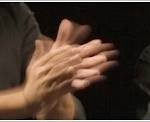
I thought I would do a quick post on the basics of Flamenco Percussion, as percussion in The Stranger from Seville (adapted from the novel, The Mapmaker’s Opera, by Béa Gonzalez) is an integral element to the sound world we create in the Musical. Contextually, we make use of the flamenco sound world especially in scenes that feature one of our main protagonists: Diego Clemente, who, in the story, emigrates to México from Seville, Spain.
Essentially Flamenco makes use of three percussive sound sources: 1. Palmas (a form of hand-clapping), 2. Pallillos (or Castanets) and 3. the Cajon.The most exciting sound, at least for me personally is the sound of palmas. The claps are essentially used to mark accents in the ‘compas’ – a way of counting through a cycle of musical beats (often 12) – much like musical accents from a drummer in other forms of contemporary popular musics. Here’s the thing: it’s not clapping in the ordinary sense (although from a distance, you’d be forgiven for thinking so) but in fact is made up of a number of variations in hard (fuertes) and soft (sordas or graves) claps, that when combined give that unmistakeable ‘flamenco’ colour. When the palmas is executed by using the fingers only of the right hand on the left palm, then this is referred to as palmas altas, or sometimes as palmas agudas. A palmas performer is known as a Palmero.
‘Palmas’ is not that easy to do, so heads up next time you hear someone doing it well!
Palillos, or castanets, are crafted from two concave “shells” attached together by string. The shells are made of stone, wood or, more commonly, fiberglass (get timber ones if you can). Usually two pairs of palillos of different sizes are used at the same time, creating a sound equally as reminiscent of the flamenco sound world as palmas. They are often employed by dancers (bailaor (m) or bailaora (f)).
The last, and most modern percussive instrument is the cajon. It was only really introduced into Flamenco music in the 1970s. It’s a box of wood in its simplest definition. The back of the instrument has a hole cut in it to amplify very low frequency notes. Often played by the side of the fist or the heel of the palm, some cajon players also use their feet. The front-piece of the instrument is often made of plywood (much thinner than the other three sides of the box) which allows for a different, more resonant, sound. Less commonly known, is that the inside of the cajon is fitted with ‘snares’ somewhat akin to the snares used on a snare drum in drumkit, and which provides the slightly buzzy sound that can emanate from the instrument when played in certain places.
And there you have it – and introduction to Flamenco Percussion. It’s very cool.